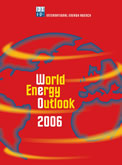Excuse Me, Can You Spare 20 Trillion Bucks?
Global Energy Infrastructure Demand
$20 trillion. That is how much in energy supply infrastructure that the world’s governments need to invest from 2005 through 2030 in order to meet the world’s growing hunger for energy, according to the International Energy Agency’s recently released report—World Energy Outlook 2006 (the “WEO”).
 I had the pleasure of attending a presentation of the main findings of the WEO by Dr. Fatih Birol, IEA’s Chief Economist and Head of the Economic Analysis Division, at the Council for Foreign Relations on November 17. By the IEA’s analysis, production of non-OPEC oil will peak within the next decade. While acknowledging that are differing views on the peak oil debate, Dr. Birol rightly observes that the question of when oil production peaks—if it has already or if it will in 10, 20 or 50 years—is moot if the infrastructure to produce and distribute oil and other energy sources are not built.
I had the pleasure of attending a presentation of the main findings of the WEO by Dr. Fatih Birol, IEA’s Chief Economist and Head of the Economic Analysis Division, at the Council for Foreign Relations on November 17. By the IEA’s analysis, production of non-OPEC oil will peak within the next decade. While acknowledging that are differing views on the peak oil debate, Dr. Birol rightly observes that the question of when oil production peaks—if it has already or if it will in 10, 20 or 50 years—is moot if the infrastructure to produce and distribute oil and other energy sources are not built.
The $20 trillion figure is a $3 trillion increase from last year’s estimates, driven by a “sharp increases in unit capital costs, especially in the oil and gas industry,” according to the executive summary of the WEO. I take this to mean, among other factors, the increase prices of metals (that are used to build the infrastructure) and, at least in the case of the U.S., hurricane-related damage to oil and gas infrastructure in the U.S. gulf region.
What accounts for this $20 trillion figure?
- China and India’s surging energy demand, especially for transportation fuel as their emerging middle classes drive demand for automobiles;
- Energy infrastructure in OECD countries built in the WWII era will be coming into retirement over the next decade, creating a huge need for replacement infrastructure.
[The gratuitous stock tip here would be to invest in global infrastructure contruction companies such as Bechtel and Fluor, which can best capitalize on this trend, especially in the Brazil-Russia-India-China (BRIC) markets]
The WEO warns that there is uncertainty as to whether the necessary investments will be made. It should be noted that the $20 trillion figure is based on a “Reference Scenario,” which assumes business-as-usual and current day energy policies. This is good news because it governments the opportunity to reassess their energy policies and induce their citizens to modify their patterns of energy consumption so as to bring that $20 trillion number down. In fact, the WEA points out that every $1 invested in efficiency in electrical appliances can offset the need of $2.20 in power infrastructure. For automobile efficiency, the ratio is $1:$2.40. The argument for demand-side management is thus very compelling; it is more than twice as cheap to reduce demand as it is to increase supply.
An Opportunity to Clean House
Dr. Birol emphasized, more than once, that the investment decisions over the next 10 years are extremely crucial because the infrastructure  we build will be here to stay for the next 60 or so years; at least two generations will have to live with the consequences of our energy choices. This is a golden opportunity to reconfigure our fossil-fuel based economy into a more sustainable, renewable and cleaner one. The Stern Review, the landmark economic assessment of climate change released last month by the British government, offers its own warning of the importance of deceisve action over the next decade--in Chapter 8, we are told that greenhouse gas emissions must peak within the next 10 to 20 years, otherwise the stablization of CO2-eqvuivalents in the atmosphere will be highly costly and technically impossible with today's policies and technologies. (See Joel Makower’s post for more background to the Stern Review) Towards a solution, the Stern Review advocates for a well coordinated and financed technology policy is needed, covering the full panoply of research, development, demonsation and deployment (RD3). According to the executive summary:
we build will be here to stay for the next 60 or so years; at least two generations will have to live with the consequences of our energy choices. This is a golden opportunity to reconfigure our fossil-fuel based economy into a more sustainable, renewable and cleaner one. The Stern Review, the landmark economic assessment of climate change released last month by the British government, offers its own warning of the importance of deceisve action over the next decade--in Chapter 8, we are told that greenhouse gas emissions must peak within the next 10 to 20 years, otherwise the stablization of CO2-eqvuivalents in the atmosphere will be highly costly and technically impossible with today's policies and technologies. (See Joel Makower’s post for more background to the Stern Review) Towards a solution, the Stern Review advocates for a well coordinated and financed technology policy is needed, covering the full panoply of research, development, demonsation and deployment (RD3). According to the executive summary:
“The private sector plays the major role in R&D and technology diffusion, but closer collaboration between government and industry will further stimulate the development of a broad portfolio of low carbon technologies and reduce costs.”
A Dire Need for Government R&D
I have previously written (see item #4 of previous post) that the clean energy sector is experiencing a venture capital boom, with some $3 billion projected by the end of the year. But the order of magnitude of clean energy technology development is of course just a component of, and a mere sliver compared to, the $20 trillion of energy infrastructure, which is really talking about the commercial scaling up of all energy technologies on a global basis. As a New York Times article points out, venture capital and private equity, while crucial, will not be a silver bullet:
“…there is a vital role for government spending, many experts agree, particularly on “enabling technologies”—innovations that would never be pursued by private industry because they mainly amount to a public good, not a potential source of profit…While private investors and entrepreneurs are jumping into alternative energy projects, they cannot be counted on to solve such problems [referring to nuclear waste and electricity storage], economist say, because event he most aggressive venture capitalists want a big payback within five years.”
Governments will have to take the lead in investing in “enabling technologies,” but as the several reports show (Joint Global Change Research Institute, Pacific Northwest National Laboratory, UC Berekely), governmental (and private) investment in R&D has declined in the U.S. and many other industrial countries. In the U.S., energy R&D, which accounts for $3 billion this year, is completely dwarfed by healthcare/biotech (almost $30 billion) and military (upwards of $75 billion) R&D (See this chart courtesy of the New York Times). Clearly, a “Manhattan Project” or “Apollo Project” for energy research is needed.
One way to make funds available for energy R&D is to eradicate the billions of dollars of energy subsidies and channel these funds to energy research. According to the WEO, subsidies on all energy sources in non-OECD countries amount to some $250 billion per year (almost all of it on fossil fuels and nuclear)—an amount equal to all investments needed in the power sector each year, in those countries. A reform of subsidies is needed, as a joint UNEP / IEA report “Reforming Energy Subsidies” argues. The report is also careful to distinguish between good subsidies and bad subsidies, but he evidence in the report suggests the majority of existing energy subsidies have net negative effects.
Whatever strategy is pursued, it is clear that strong global political will is needed to meet the formidable challenge of creating a sustainable energy future. International institutions and frameworks, such as the G8, G20, UNFCCC / Kyoto Protocol and Energy Charter Treaty can play important roles, but it is imperative that action starts sooner rather than later.
Related:
Last week’s issue of The Economist highlights in its cover story "Green Dreams":
“[c]lean energy fever is being fuelled by three things: high oil prices, fears over energy security and a growing concern about global warming…Analysts confidently predict that the clean-energy business will grow by 20%-30% a year for a decade.”
While it is good news that clean energy investments are all the rage with venture capitalists and investors, the bad news is that the 20%-30% growth rate comes off a tiny base as a proportion of all energy sources, so that in a decade’s time, clean energy will still only make up maybe 15% of the world’s energy sources, assuming the very high range of the growth rate. Given that our energy infrastructure built over the next decade has a 60 year shelf life, and short of any technological break through in the clean energy realm, conventional fossil fuel and nuclear infrastructure will likely continue to dominate.
All the more reason for a ramp up in energy R&D.

0 Comments:
Post a Comment
Subscribe to Post Comments [Atom]
<< Home